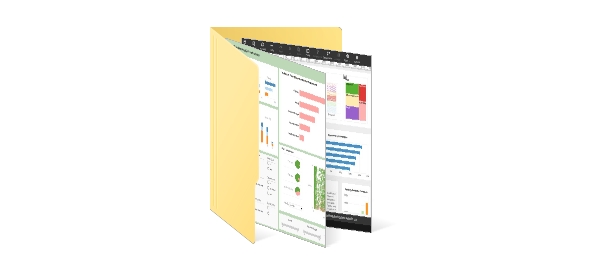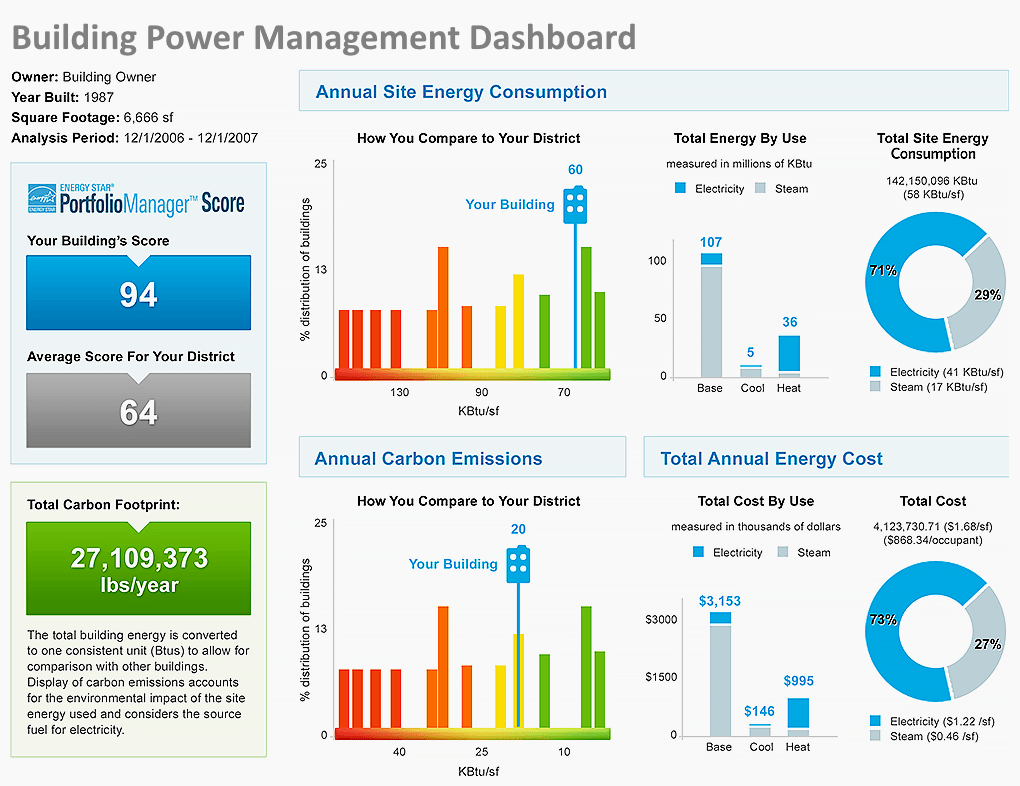What KPIs and Analytics Are Used on Building Power Management Dashboards?
Power management has become a crucial issue for companies and institutions, building owners and facilities managers.
Power management dashboards are essential for monitoring and improving energy-related activities to reduce operating costs, reliable power supply, LEED ratings, and environmental effect.
This article explores power management dashboards and the KPIs and analytics used to make educated decisions and optimize energy efficiency.
| #1 Ranking: Read how InetSoft was rated #1 for user adoption in G2's user survey-based index | Read More |
Energy Consumption Metrics
Total Energy Consumption
One of the key performance indicators (KPIs) in power management is the overall energy usage. It shows the total energy used by a facility over a certain time frame and is often expressed in kWh. Organizations may establish baseline consumption levels and monitor advances in energy efficiency by keeping an eye on this KPI.
Energy Intensity
The quantity of energy used per square footage or unit of output is measured by energy intensity. It's an essential KPI for evaluating energy efficiency across various facilities and benchmarking, allowing one to pinpoint failing or high-performing assets.
Power Quality Metrics
Voltage Fluctuations
Power management is often concerned with voltage variations. Variations in voltage levels are tracked as part of power quality measurements since they may affect device longevity and efficiency. Power management dashboards often include graphs and voltage fluctuation warnings in real time.
Harmonic Distortion
The degree to which non-sinusoidal waves are present in the power source is measured by harmonic distortion. Overly high harmonics may cause overheating of the equipment, higher losses, and worse energy efficiency. Harmonic distortion levels are tracked by dashboards and reported on.
Demand and Load Management
Peak Demand
Peak demand, which is often expressed in kilowatts (kW), is the maximum amount of electricity used during a certain time period. Organizations may save energy expenses during peak hours by using demand response systems and keeping an eye on peak demand.
Load Profiling
Analyzing and displaying the power consumption distribution across time is the process of load profiling. It assists in spotting trends, load imbalances, and possible areas for energy savings. Dashboards provide tools for load profiling so users may learn about patterns in usage.
Renewable Energy Integration
Renewable Energy Generation
Renewable energy sources like wind turbines and solar panels are being integrated into the electrical infrastructure of many companies. To guarantee that these systems function well and help reduce energy costs, real-time output monitoring is crucial. Dashboards for power management include statistics on consumption as well as renewable energy production.
Carbon Emission Tracking
The issue of sustainability is becoming more and more important, and energy use directly contributes to carbon emissions. Carbon emission-related KPIs are often included in dashboards and may be utilized for both corporate social responsibility initiatives and regulatory compliance.
 |
Learn about the top 10 features of embedded business intelligence. |
Equipment Efficiency Metrics
Power Factor
The efficiency with which electrical power is transformed into usable work output is indicated by the power factor. A power factor that is near to 1.0 indicates effective power use, while a power factor that is lower might suggest energy waste. Power factor is continually monitored by power management dashboards, which also provide notifications for remedial action.
Equipment Performance
Optimizing energy efficiency requires constant observation of the functioning of important equipment, including industrial machinery, HVAC systems, and lights. Through dashboards, operators may monitor these systems' real-time functioning and set up performance KPIs.
Predictive Analytics
Predictive Maintenance
Based on past performance data, predictive analytics in power management dashboards may predict equipment breakdowns. By planning maintenance ahead of time, this function lowers repair costs and helps avoid unplanned downtime.
Energy Consumption Predictions
Energy usage trends may be analyzed using predictive analytics, which helps project future energy requirements. Budgeting and making sure the facility has a sufficient power supply during peak hours both benefit from this knowledge.
 |
Learn the advantages of InetSoft's small footprint BI platform. |
Cost Analysis
Cost of Energy
For companies looking to save operating costs, it is essential to comprehend the cost of electricity. With the use of power management dashboards, which provide thorough cost breakdowns, businesses may pinpoint areas that might benefit from energy-saving initiatives.
Return on Investment (ROI) Analysis
Investments in power management, including energy-efficient renovations, might be quite expensive. Dashboards are capable of doing ROI analysis, which determines how long it will take for energy savings to repay the investment.
Real-time Alerts and Notifications
Threshold Alarms
A fundamental component of power management dashboards are threshold alerts. They provide for prompt reactions to problems or abnormalities by alerting operators when parameters like as voltage levels, energy usage, or other variables surpass predetermined thresholds.
Integration and Interoperability
Integration with Building Management Systems (BMS)
BMS and power management dashboards are often connected to provide a comprehensive picture of building operations. Improved control over HVAC, lighting, and other systems to maximize energy efficiency is made possible by this integration.
Data Integration and Open Standards
Power management dashboards may interface with numerous sensors, meters, and control systems thanks to open standards and data integration capabilities, giving users a full view of energy data from several sources.
 |
View the gallery of examples of dashboards and visualizations. |
User-friendly Interfaces
Dashboard Customization
With configurable dashlets and widgets, power management dashboards provide easy-to-use interfaces that help users create bespoke views that highlight the KPIs most relevant to their goals and roles.
Historical Data Analysis
With the use of historical data analysis tools, users may do thorough analyses of energy consumption patterns and trends, which can facilitate long-term strategic planning and decision-making.
Environmental Impact Metrics
Water Usage
Water use may affect the environment, even if it isn't exactly an energy-related KPI. Water use monitoring is a feature of many power management dashboards, particularly in establishments where water-intensive operations are necessary.
Waste Management and Recycling
Monitoring recycling and trash production rates may be a component of a larger sustainability plan. These parameters may be monitored by power management dashboards in order to evaluate how energy-related activities affect the environment.
 |
Read the top 10 reasons for selecting InetSoft as your BI partner. |
Energy Efficiency Benchmarking
Energy Star Ratings
A standard for energy efficiency is provided by Energy Star ratings, which are integrated into some power management dashboards. Organizations may use this KPI to compare their energy performance to industry norms.
LEED Certification Metrics
Power management dashboards are often used by organizations seeking Leadership in Energy and Environmental Design (LEED) certification to monitor the metrics needed for certification, such as sustainability and energy efficiency.
Energy Procurement and Contracts
Energy Cost per Unit
For manufacturing and industrial operations, knowing the cost of energy per unit of output might be essential. This KPI aids in assessing how cost-effective energy purchase agreements are.
Contract Compliance
KPIs for contract compliance, which verifies that the conditions of energy procurement contracts are fulfilled and that the company obtains the agreed-upon prices and services, may be included in power management dashboards.
User Behavior Analytics
Occupancy Analytics
Monitoring occupancy levels in business buildings may aid in maximizing energy use. Based on the presence of inhabitants, dashboards with occupancy analytics may reveal where and when energy is being used.
User-Driven Actions
Power management dashboards may provide insights into how user-driven activities affect energy use by examining user behavior. Programs for staff training and energy-saving measures may be developed using this data.
Grid Integration and Demand Response
Grid Reliability and Stability
Grid performance data may be integrated into power management dashboards, enabling businesses to evaluate the electrical grid's dependability and stability, which can affect energy prices and availability.
Demand Response Participation
Demand response program participants have the ability to monitor their involvement and assess the financial and environmental advantages of cutting down on energy use during peak hours.
 |
Learn how InetSoft's native big data application is specifically designed for a big data operating system. |
Security and Compliance
Cybersecurity Monitoring
Cybersecurity is a major worry as power management becomes more digitalized. KPIs pertaining to cybersecurity standards compliance and the security of energy management systems may be seen on dashboards.
Regulatory Compliance
It is crucial to make sure that energy-related laws and standards are followed. KPIs linked to regulatory compliance may be included in power management dashboards, assisting businesses in avoiding fines and legal problems.
Energy Use Intensity (EUI) and Site Energy
Energy Use Intensity (EUI)
A KPI called EUI assesses how much energy a facility uses per square foot. It is especially helpful for monitoring advancements and comparing the energy efficiency of various structures.
Site Energy Consumption
Dashboards often show site energy consumption, which is the total amount of energy consumed at a particular site or facility, in addition to overall energy consumption. This KPI is crucial for comprehending how much energy is used at different places.
 |
Read how InetSoft saves money and resources with deployment flexibility. |
Peak Load Forecasting
Peak Load Prediction
Peak load forecasting projects future peak demand using predictive analytics and historical data. Planning for capacity and making sure the facility has enough electricity during peak hours depend heavily on this KPI.
Energy Cost Allocation
Cost Allocation by Department/Unit
Accurate energy cost allocation is crucial in bigger enterprises with several departments or divisions. In order to aid in internal cost accountability, dashboards might include KPIs that break down energy expenses by department or business unit.
 |
Learn about the top 10 features of embedded business intelligence. |
Carbon Offset Metrics
Carbon Offset Calculation
To reduce their carbon emissions, several businesses make investments in carbon offset schemes. Dashboards for power management may include key performance indicators (KPIs) to monitor the efficiency of these initiatives in lowering the company's total carbon footprint.

